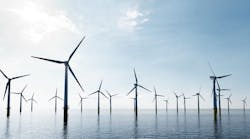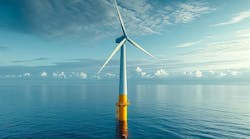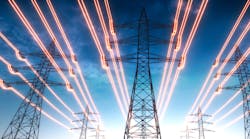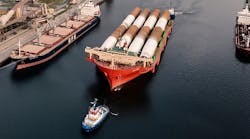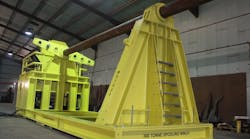Editor's note: A condensed version of this story first appeared in the 2023 Offshore Wind Special Report, which published within the September/October 2023 issue of Offshore magazine.
By Ariana Hurtado, Editor and Director of Special Reports
The state of New Jersey is targeting 7,500 MW of offshore wind power capacity by 2035 and 11,000 MW by 2040, and Virginia is aiming for 5,400 MW by 2034.
Sam Salustro, vice president of strategic communications at the Business Network for Offshore Wind, recently shared his insights with Offshore on the trends and market forecasts for wind projects offshore these two states.
“Judging by recent auction results, the US is a premier market for investment,” Salustro said. “In four recent auctions, states with strong policy mechanisms and shallow waters for rapid deployment, which includes New Jersey, saw plots go for between $500 million and $1 billion.”
However, it’s a bit of a different story, he explained, as Virginia is forecast to have lower auction prices.
“Virginia will see a lease auction next year, and the state’s emerging supply chain and general support for offshore wind should drive significant interest; however, the state lacks the most stringent policy mechanisms, which will likely result in auction prices below what was recently seen in New York and New Jersey.”
To help support supply chain and workforce development, Salustro said the federal government offers credits on auction revenues for project developers pledging to invest in a regional market.
Key players
Offshore Virginia, Dominion Energy is developing the largest offshore wind farm in the US—the 2.6-GW Coastal Virginia Offshore Wind project, which is expected to be fully constructed in 2026.
Investment growing
Offshore wind developers face a variety of challenges in the northeast US region, but Salustro offered some suggestions to address these issues.
“As a general rule across the entire US, the industry must build up a more robust supply chain and vessel fleet to ensure that national and state goals are met in the face of tightening global supply chains and rising demand,” he said. “Individual states are the demand drivers in the US, and their continued strong demand for offshore wind (87 GW), coupled with recent significant federal investment and permitting support, has unleashed a wave of investments across the nation.”
According to the Business Network for Offshore Wind’s market tracking database, $16.6 billion in new investments in ports, vessels, manufacturing facilities and more have flowed into the US since 2021.
“The addition of the Inflation Reduction Act and its generous tax provisions can drive even more investment, which is desperately needed if the US expects to compete with the global market for component suppliers,” he added.
“In the short term, inflation and resulting cost overruns have also posed issues for developers,” he continued. “But, in some cases, states have been willing to find paths forward in response to these cost overruns. Similar understanding from other states would go a long way toward alleviating these concerns.”
Tax break debate
Recently, New Jersey residents sued developer Orsted and the state over a tax break the company received to build a major offshore wind farm in the Atlantic, claiming the estimated $1 billion subsidy violates the state constitution, according to a Reuters report.
Defend Brigantine Beach and Protect our Coast NJ filed their lawsuit on July 27 in state court. The groups claimed the law authorizing the tax break violates a provision of the state constitution that generally prohibits legislation that specifically favors a single, private entity. The groups asked the court to invalidate the law, which they said created the tax break “for the singular purpose of protecting Orsted from commercial risk it voluntarily assumed” when it submitted bids to develop the project, known as Ocean Wind.
Orsted said on July 28 that it does not comment on pending litigation.
Permitting systems
Sometimes developers can face offshore wind permitting issues, including challenges from fishing groups off the US northeast coast.
“The US federal government follows an extensive environmental review process that ensures that projects are advanced in environmentally responsible manners—that includes taking into consideration potential impacts on fishing and tourism,” Salustro said. “The industry looks to the federal government to bring greater certainty to the permitting process through consistency and transparency. The US permitting system can take upward of eight years to complete, a lengthy period that put projects at risk for changing economics and supply chain constraints. As a result, creating a strong market requires fostering confidence in the permitting system to advance projects in a timely manner that also ensures environmental protections to build public support.”
Looking ahead
So, what's the path forward for the offshore wind sector in the northeast US region?
“The first two commercial-scale offshore wind projects are finally being installed, and soon 932 MW of reliable, affordable and clean power will be transmitted to the grid,” Salustro said. Behind these two projects are two more, totaling nearly 2 GW, that could soon begin installation activities shortly. Behind these four projects is a pipeline of over 13 GW of projects awaiting final environmental approval, and 30 GW more beginning to work through the system and secure offtake agreements.”
New Jersey has set an 11-GW offshore wind target that Salustro said will drive significant investment into the region. He added, “Already the state is home to a new monopile foundation facility and a world-class port capable of supporting installation activities—a rarity on the US East Coast. The state will soon finalize a solicitation round for up to 4 GW of power generation and a second round of transmission planning.”
Additionally, the 2.6-GW Coastal Virginia Offshore Wind Commercial project will soon be under construction and will take up to three years for full installation.
“The project is supporting the siting of a blade facility and new installation vessel,” Salustro concluded. “Virginia’s legislature had mandated another 2.6 GW be connected to the grid by 2035 and could increase that number as the Commonwealth is becoming the center of the US data center industry, drawing significant power from existing infrastructure.”


